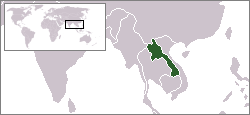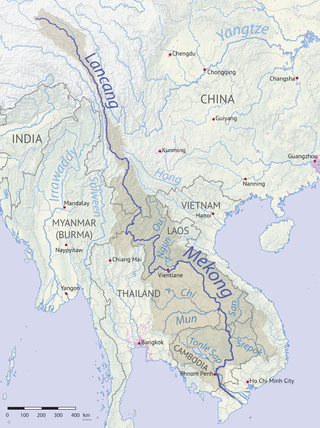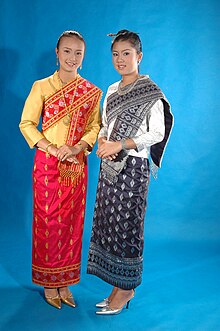
Laos, officially the Lao People's Democratic Republic, is a socialist state and the only landlocked country in Southeast Asia. At the heart of the Indochinese Peninsula, Laos is bordered by Myanmar and China to the northwest, Vietnam to the east, Cambodia to the southeast, and Thailand to the west and southwest. Its capital and largest city is Vientiane.

The politics of the Lao People's Democratic Republic takes place in the framework of a one-party parliamentary socialist republic. The only legal political party is the Lao People's Revolutionary Party (LPRP). The head of state is President Thongloun Sisoulith, who is also the LPRP general secretary, making him the supreme leader of Laos. The head of government is Prime Minister Phankham Viphavanh.
Land law is the form of law that deals with the rights to use, alienate, or exclude others from land. In many jurisdictions, these kinds of property are referred to as real estate or real property, as distinct from personal property. Land use agreements, including renting, are an important intersection of property and contract law. Encumbrance on the land rights of one, such as an easement, may constitute the land rights of another. Mineral rights and water rights are closely linked, and often interrelated concepts.

Hmong Americans are Americans of Hmong ancestry. Many Hmong Americans immigrated to the United States as refugees in the late 1970s. Over half of the Hmong population from Laos left the country, or attempted to leave, in 1975, at the culmination of the Laotian Civil War.
Widow inheritance is a cultural and social practice whereby a widow is required to marry a male relative of her late husband, often his brother. The practice is more commonly referred as a levirate marriage, examples of which can be found in ancient and biblical times.

The status of women in Nepal has varied throughout history. In the early 1990s, like in some other Asian countries, women in Nepal were generally subordinate to men in virtually every aspect of life. Historically, Nepal has been a predominantly patriarchal society where women are generally subordinate to men. Men were considered to be the leader of the family and superior to women. Also, social norms and values were biased in favor of men. This strong bias in favor of sons in society meant that daughters were discriminated against from birth and did not have equal opportunities to achieve all aspects of development. Daughters were deprived of many privileges, including rights, education, healthcare, parental property rights, social status, last rites of dead parents, and were thought to be other's property and liabilities. In the past century, there has been a dramatic positive change in the role and status of women in Nepal, reducing gender inequality. While the 1990 Constitution guaranteed fundamental rights to all citizens without discrimination on the basis of ethnicity, caste, religion, or sex, the modernization of society, along with increased education of the general population, have also played an important role in promoting gender equality. The roles of women have changed in various ways in the modern Nepalese society.
Gender inequality in India refers to health, education, economic and political inequalities between men and women in India. Various international gender inequality indices rank India differently on each of these factors, as well as on a composite basis, and these indices are controversial.

The Constitution of Laos specifies the functions and powers of the government of the Lao People's Democratic Republic, and defines the rights and duties of Laotian citizens. The constitution was adopted on August 14, 1991, sixteen years after the 1975 establishment of the Republic, a period during which the country functioned without a written constitution or published penal and criminal codes. It consists of a Preamble and Articles, and legally establishes a set of authorities that resemble the traditional differentiation among executive, legislative, and judicial branches of government.
Healthcare in Laos is provided by both the private and public sector. It is limited in comparison with other countries. Western medical care is available in some locations, but remote areas and ethnic groups are underserved. Public spending on healthcare is low compared with neighbouring countries. Still, progress has been made since Laos joined the World Health Organization in 1950: life expectancy at birth rose to 66 years by 2015; malaria deaths and tuberculosis prevalence have plunged; and the maternal mortality ratio (MMR) has declined by 75 percent.

The status and social roles of women in Mali have been formed by the complex interplay of a variety of traditions in ethnic communities, the rise and fall of the great Sahelien states, French colonial rule, independence, urbanisation, and postcolonial conflict and progress. Forming just less than half Mali's population, Malian women have sometimes been the center of matrilineal societies, but have always been crucial to the economic and social structure of this largely rural, agricultural society.

Lesbian, gay, bisexual and transgender (LGBT) rights in Laos go unreported and unnoticed. While homosexuality is legal in Laos, it is very difficult to assess the current state of acceptance and violence that LGBT people face because of government interference. Numerous claims have suggested that Laos is one of the most tolerant communist states. Despite such claims, discrimination still exists. Laos provides no anti-discrimination protections for LGBT people, nor does it prohibit hate crimes based on sexual orientation and gender identity. Households headed by same-sex couples are not eligible for any of the rights that opposite-sex married couples enjoy, as neither same-sex marriage nor civil unions are legal.
Women's property rights are property and inheritance rights enjoyed by women as a category within a society.

Women in Cambodia, due to the influence of the dominant Khmer culture, are traditionally expected to be modest and soft-spoken. They are to be well-mannered, industrious, and hold a sense of belonging to the household. It is expected that they act as the family's caregivers and caretakers, financial administrators, and serve as the "preserver of the home". As financial administrators, women can be identified as having household authority at the familial level. Khmer women are expected to maintain virginity until marriage, become faithful wives, and act as advisors to their husbands. Women in Cambodia have also be known as “light” walkers-- "light" walking and refinement of the Khmer women is further described as being "quiet in […] movements that one cannot hear the sound of their silk skirt rustling".

Women's societal roles in Brazil have been heavily impacted by the patriarchal traditions of Iberian culture, which holds women subordinate to men in familial and community relationships. The Iberian Peninsula, which is made up of Spain, Portugal and Andorra, has traditionally been the cultural and military frontier between Christianity and Islam, developing a strong tradition for military conquest and male dominance. Patriarchal traditions were readily transferred from the Iberian Peninsula to Latin America through the encomienda system that fostered economic dependence among women and indigenous peoples in Brazil. As the largest Roman Catholic nation in the world, religion has also had a significant impact on the perception of women in Brazil, though over the past century the Brazilian government has increasingly broken with the Catholic Church in regard to issues related to reproductive rights.

Women in Bulgaria refers to women who live in and are from Bulgaria. Women's position in Bulgarian society has been influenced by a variety of cultures and ideologies, including the Byzantine and Ottoman cultures, Eastern Orthodox Christianity, communist ideology, and contemporary globalized Western values.
The evolution and history of women in Asia coincide with the evolution and history of Asian continent itself. They also correspond with the cultures that developed within the region. Asian women can be categorically grouped as women from the Asian subregions of Central Asia, East Asia, North Asia, South Asia, Southeast Asia, and Western Asia.
Violence against women, particularly intimate partner violence and sexual violence, is a major public health problem and a violation of women's human rights in Pakistan. Violence against women in Pakistan is part of an issue that faces the entire region the country is situated in. Pakistan is a highly patriarchal society, and took a long time to enact laws for the protection of women. In the 2019 Women, Peace and Security Index, Pakistan ranked 164 out of 167 countries. Pakistan is worst among nine South Asian countries on access to mobile phones, financial inclusion, and discriminatory norms for women. Around 12.2 million girls, compared with 10.6 million boys, remain out of school in Pakistan, poverty compounding challenges to girls' educational opportunities. The only positive to take from the Index was Pakistan's achievement of 20 per cent representation for women in parliament and a slightly better indicator than India on bias towards sons. In 2017 there were an estimated 746 honour crimes, 24 stove burnings, 18 cases of settlement marriages. Many cases go unreported, and many of these reported cases go unprosecuted. Alternative Dispute Resolution (ADR) system in 2017 has been hailed as a success in Khyber Pakhtunkhwa. Legal experts are critical of the system, noting that ADR can delay action. Many remain concerned with patriarchal influence in a decision-making process that has traditionally disadvantaged women. In 2019, the Ombudsman for Sindh province informed the Supreme Court that out of 350 cases, action was taken in just eight cases. The largest province, Punjab, has received 116 complaints since the establishment of the office in 2013, resulted in 42 convictions, 15 acquittals, 27 withdrawals, and 24 still ongoing cases. It also reviewed 13 appeals. Four decisions were set aside, five decisions upheld, two cases were declared time-barred, while two remain ongoing. Women in Pakistan mainly encounter violence by being forced into marriage, through workplace sexual harassment, domestic violence and by honour killings.
Gender inequality has been improving a lot in Bangladesh, inequalities in areas such as education and employment remain ongoing problems so women have little political freedom. In 2015, Bangladesh was ranked 139 out of 187 countries on the Human Development Index and 47 out 144 countries surveyed on the Gender Inequality Index in 2017. Many of the inequalities are result of extreme poverty and traditional gender norms centred on a patrilineal and patriarchal kinship system in rural areas.

Women living in Myanmar continue to face barriers to equality. After forty years of isolation, myths about the state of women's rights in Myanmar (Burma) were centered around the conception that Burmese women face less gender discrimination and have more rights than women in surrounding Southeast Asian nations. After Myanmar opened its borders in 2010, gender discrimination began to be seen by the international community. Currently, a variety of organizations--both domestic and international--strive to educate people that this is a misconception to better make strides towards protecting women's rights in Myanmar.

Laos is a nation with plentiful surface water and broad rivers, but outside of cities there is little infrastructure to make that water clean and accessible. Very little improvement has been made since the end of the Laotian Civil War in 1975, especially compared to peer nations such as Thailand. By 2015, 76% of Laotians nationwide were estimated to have access to “improved” water, while 71% were estimated to have access to “improved” sanitation.

















